 |
| Category: Army
today/RAR |

|
|
|
|
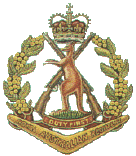
|
Raised
|
18 January 1952
|
1 February 1964
|
|
Battalion colour
|
Scarlet (BCC 209)
|
|
Battalion nickname
|
The Fighting Fourth
|
|
Battalion march
|
Inverbrackie 
|
|
Current home
|
Holsworthy, Sydney, NSW
|
|
Mascot
|
|
|
Now known as 4 RAR
(Commando) |
|
Tours of duty overseas. |
| Malaysia |
October 1965-October 1967 |
| Viet Nam |
1 June 1968 - 31 May 1969
and May 1971-Dec 1971 (D Coy- Feb 1972) |
|

|
"The
Fighting Fourth" 4RAR/NZ (ANZAC) 1971/1972 |
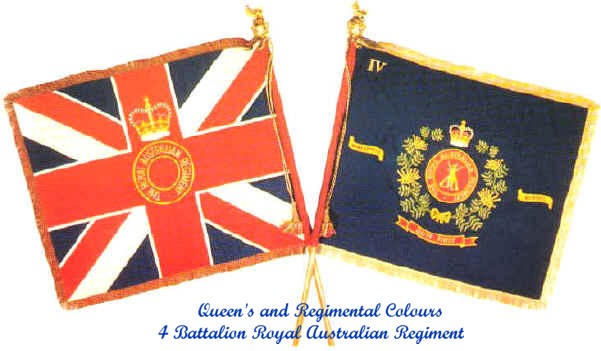
| Battalion Colours.
(Pictured are the Colours circa
1970) The history of Colours is
covered comprehensively on other pages of this site. The tradition of
colours and the strict conventions applied and the respect accorded them
must be a matter of common knowledge for every soldier. An officer or
soldier passing uncased Colours of his own regiment or other corps or
friendly service is to salute them. Colours are the jealous possession
of the battalion. They do not leave the Battalion's possession when in
service. No one but the Battalion may claim them. When they are being
moved from, or to the place they are usually kept, they are to be
escorted. When the colours are not being carried they are to be housed
in the Officers Mess. When the Battalion is on active service or
functioning in such a way that its custody of the Colours is not
possible, the Colours are housed for safe keeping before leaving
Australia. Gloves are to be worn at all times while carrying the
colours. The Battalion was presented new colours on 12 October 1984, by
the Governor General, The Right Honourable Sir Ninian Stephens, AK,
GCMG, GCVO, KBE and laid up the old colours on 13 October 1984. The
Commanding Officer at the time LTCOL M.J. Keating and the RSM, WO1 J.H.
Dunshea, paraded the colours for the last time to the All Saints Chapel
at Lavarack Barracks where they remained until 9 May 1995. The colours
were then relocated to Sydney where they are now on show in the
Battalion Headquarters building. The soldiers can view the colours to
maintain the traditions of the Regiment. The old Queen's Colour is the
design of the Union Jack and the current Queen's Colour is the design of
the Australian National flag. |

|
HISTORY OF 4 RAR
including
4RAR/NZ (ANZAC) |
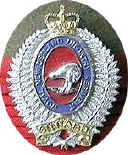
|
| This
page is dedicated to the CQMS of Delta Coy. 4RAR/NZ (ANZAC) on their
second tour, S/Sgt (later WO1) R J 'Bob'
Hann.
|
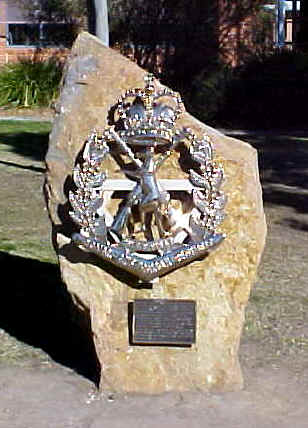 |
On 18 January 1952, a Royal
Australian Regiment Depot was raised as a training unit for special
establishment on the Order of Battle.
The Depot was later renamed 4 RAR,
on 10 March 1952.
This renaming was necessary because Government approval
had been given to raise a Battalion and not a Depot.
The primary function
of 4 RAR at the time was to train and hold infantrymen for service in
Korea.
On 24 March 1960, the unit was incorporated into the School of
Infantry as Depot Company, The Royal Australian Regiment.
<< The gate badge of 4RAR
Depot which is now on display at Infantry Centre, Singleton |
The decision to
raise the Fourth Battalion of The Royal Australian Regiment was made in
1963.Consequently, instructions for the
raising of the Battalion were issued on 13 January 1964. The official
raising of 4 RAR on 1 February 1964, resulted in the first regular
Battalion to be raised on Australian soil.
Additionally it was stated that
this battalion is a new battalion and not a resurrection
of the old 4 RAR
Depot. The Battalion was first raised under command of LTCOL D.S. Thomson,
MC and WO1 L.E. Brennan.
On 1 February 1964, the Inauguration
Parade for 4 RAR took place at Woodside South Australia.
Two other very significant events took place concurrently. Firstly, on 11
April, 1965, the Governor-General, Viscount De L'Isle VC, PC, GCMG GCV0,
presented the Queen's And Regimental Colours to the battalion. Afterward,
the Governor-General suggested that to mark his visit the Assault Pioneers
should wear beards, as was the custom in his own regiment, the Grenadier
Guards. Subsequently, the 4 RAR Assault Pioneer Platoon Sergeant became
the only soldier in the Australian Army permitted to wear a beard .
In October 1965, 4 RAR joined 28
COMWEL Ind Bde Gp at Terendak Camp in Malaysia. Training was intensified
immediately as the unit was placed on a short notice to move to Sarawak.
While training, the Battalion had platoons and companies on varying
degrees of alert in case if Indonesian incursions across the Malacca
Straits onto the Malay Peninsular. In April 1966, the Battalion was
deployed to the Bau District. Battalion HQ was located at Cambrai Camp.
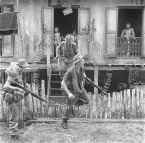 |
Borneo, 1966-06. Soldiers
from the 4th Battalion, The Royal Australian Regiment, moving from hut
to hut in a village as they carry out a routine patrol along the
Malaysian-Indonesian border. Left to right: Corporal John Maloney,
from Coburg, Victoria; Private (Pte) Bill McBride, of Albany, WA, on
the steps of the hut; and Pte Arthur Francis, of Cessnock, NSW. |
Three of the rifle companies occupied bases at Gumbang, Stass and Bokah.
The remaining rifle company was held as a reserve at Old Bau Camp.
Documents captured by C Company, under Major K.J. McGhee, in a June 15
contact with an Indonesian Army infiltration group proved of great
importance to operations in Sarawak and to political manoeuvres during the
closing stages of confrontation. An important facet of the Borneo tour was
the unit's hearts and minds campaign. Aid, in the form of construction,
supply, employment and medical treatment, was given to local villages.
At the conclusion of
"'Confrontation" in early September the bases occupied by 4 RAR
were handed over to 3 Royal Malay Regiment. By 10 September 1966, 4 RAR
was completely relocated to Malacca. On 11 November 1966, Lieutenant
Colonel D.S. Thomson, MC handed over command of 4 RAR to Lieutenant
Colonel C.H.A. East, MBE. The unit continued to participate in it's role
as part of the British Commonwealth Far East Strategic Reserve. During
this period the percentage of national Serviceman in the battalion
increased, as a large number of regular soldiers returned early to
Australia to go as reinforcements to Vietnam.
Lt Col East instituted a civic
action scheme which was extremely successful. Initially the battalion
adopted a Malay village, where it applied the Malay custom of "mutual
assistance".
During September and October 1967 4RAR returned to Australia and settled
at Enoggera Barracks, Brisbane, where on 9 January 1968, Lt Col L.R.
Greville replaced Lt Col East as commanding officer.
The battalion was reduced by one rifle company for its ANZAC role in
Vietnam, where it was to take over two New Zealand companies.
From 4 RAR's time in
Malaysia and Sarawak the Battalion will remember the following soldiers.
-
Private
P. Robinson
-
Corporal
P.J.J. West
-
Corporal
R.C. Patch
-
Private
J.W. Jones
-
Private
L.W. O'Carroll
-
Private
V.H.Richards
WE
WILL REMEMBER THEM
LEST
WE FORGET
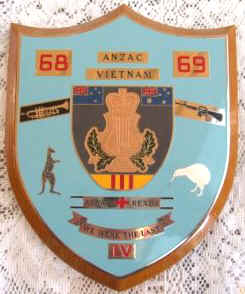 |
1st Tour Vietnam 1 June 1968 - 31
May 1969
On 13 May 1968 an advance party from
4 RAR moved by air to South Vietnam.
This group arrived on South Vietnam on
14 May 1968.
The main body of the Battalion departed on 21 May 1968 and
travelled to Vietnam aboard HMAS Sydney.
The battalion took over from 2RAR
on 21 June at the 1st Australian Task Force Base, Nui Dat, Phuoc Tuy
Province.
|
 |
Bien Hoa province,
South Vietnam, 1968-06. A resupply helicopter is being unloaded at fire
support base (FSB) Concord in northern Bien Hoa province shortly after
the base had been set up by 4RAR/NZ (ANZAC) (the Anzac battalion
comprising 4th battalion, the Royal Australian Regiment and a component
from the 1st Battalion, Royal New Zealand Infantry Regiment). At the
base with the Anzac battalion are armoured personnel carriers of 'A'
Squadron, 3rd Cavalry Regiment, howitzers of 104th Field Battery,
Royal Australian Artillery (RAA), and self propelled guns of an American
battery. |
|
Two Royal New Zealand Infantry
Regiment Companies, V (Victor) and W (Whisky), joined the
Battalion and it became 4RAR/NZ (Anzac) Bn
for its twelve month tour of
Vietnam.
During its year long tour in South Vietnam the Battalion completed
11 major operations and five operations of company size.
The Battalion
returned home to Australia to Enoggera in May 1969, as part of 6 TF, 1 Div
and later relocated to Townsville, as part of the 3 TF, 1 Div in December
1969.
|
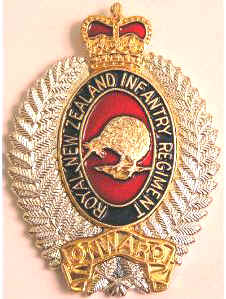 |
Awards
| Distinguished
Service Order |
Lt
Col L R Greville |
| Military
Cross |
Second
Lieutenant Thomas Gary Reidy
Maj William John Reynolds
Maj John Pericles Deighton
Lt Maurice Francis Dodson (V Company)
Lt Brian Charles Barley (W Company) |
|
Military Medal
|
Cpl
Wayne Laurence Brown |
| Distinguished
Conduct Medal |
Sergeant
Michael Rupert Carroll
Sgt John Aitchison Kennedy
Cpl Malcolm Gibson
L/Cpl Arohanui Leonard Ropeta (V Company)
Sgt John Grant Sandford |
| Mentioned
in Dispatches |
Maj
Brian David Lindsay
Maj Michael Chisholm Morrison
Capt James Rollo Brett
Capt Peter Kenneth Sharp
2Lt Peter James Sheedy
WO1 Anthony Charles Toghill
WO2 Robert Richardson MM
WO2 Leslie George O'Keefe
Sgt Noel Robert McParland
Cpl Kenneth Bruce Miller
2Lt John Lindsay Burns (12 Field Regt)
Sapper Wiki Kahika (V Company)
Richard John Foster
|
|
|
Second tour of Viet Nam
May 1971- Dec 1971 (except
D Coy left SVN 29
Feb 1972 - arrived Australia 13 Mar 72)
 The
Battalion's advance party departed Australia on 30 Apr 71, for the unit's
second tour of Vietnam only this time lead by LTCOL Hughes and the RSM WO1
W.T.C. Thompson took over on 1 Jun 70 and looked after the men until 14 Aug
73. The
Battalion's advance party departed Australia on 30 Apr 71, for the unit's
second tour of Vietnam only this time lead by LTCOL Hughes and the RSM WO1
W.T.C. Thompson took over on 1 Jun 70 and looked after the men until 14 Aug
73.
<< In the rubber
During the voyage the infantrymen of the Battalion,
( one hundred and
forty-one of them had previously seen service in South Vietnam) trained
on the flight deck of the carrier, keeping in top condition.
The New Zealanders joined the advance party at Nui Dat in
early May 71, having come from Singapore. The main body arrived on 22 May 71,
and operations began soon after the Battalion concentrated at Nui Dat. The
Battalion relieved 2 RAR/NZ (ANZAC) at midnight on 23 May 71.
4 RAR/NZ (ANZAC) after a week settling in and 'In theatre
training' moved to the bush for the remaining seven and a half months of its
tour. This meant the soldiers spent their tour entirely on operations during
the monsoon season. The ANZAC Battalion conducted nine operations against
their main targets, the 274 Viet Cong (VC) Main Force Regiment and the 33rd
North Vietnamese Army Regiment.
On 18 Aug 71, Prime Minister W. McMahon announced the
withdrawal of troops by Christmas, and in Dec 71, the Battalion less Delta Coy
and 1 Tp, B SQN, 3 Cav Regt returned to Townsville, Australia on the troop
carrier HMAS SYDNEY. Delta Coy remained at Vung Tau until 13 Mar 72.
For 4 RAR/NZ (ANZAC), this final tour gave the Battalion the
honour of being the last ANZAC Battalion to serve in South Vietnam (also 4 RAR
was the last Battalion to leave Borneo in 1966). As the last Battalion out of
South Vietnam, it was witness to the unique circumstances of the withdrawal,
none of them being foreseen during the deployment to South Vietnam. During its
tour of duty the Battalion killed 91 enemy and captured 5 for the loss of
eight 4 RAR/NZ (ANZAC) soldiers.
 |
Nui Dat, South Vietnam.
November 1971. Lowered for the last time. A simple ceremony by a small
element of 4RAR /NZ (ANZAC) (The ANZAC Battalion comprising 4th
Battalion, The Royal Australian Regiment and a component from the 1st
Battalion, Royal New Zealand Infantry Regiment), saw the Australian,
4RAR and Royal New Zealand Infantry Regiment flags lowered for the last
time and marked more than five years occupancy of the base by
Australians and New Zealanders. The flag lowering ceremony was carried
out by New Zealand Regimental Policeman Private Tai Whatu and Australian
Regimental Policeman Private John Skennar of Grafton, NSW. |
The Battalion remembers these soldiers from
the second tour for the sacrifice they made.
- Private B.M. Pengilly
-
Private J. Duff
-
Private R.J. Niblett
-
Private B.C. Beilken
-
Private K.M. Kingston-Powels
-
Private R.J. Sprigg
-
Private M.L. Rhodes
-
Corporal C.F. Wilkinson
- Pte K H Harding (1RNZIR)
|
WE WILL REMEMBER THEM
LEST WE
FORGET
|
AWARDS , SECOND TOUR
| Distinguished
Service Order (DSO) |
- Lieutenant-Colonel J. C. Hughes,
M.C.
|
| Military
Cross (MC) |
- Major J. H. Taylor
- Second-Lieutenant G. J. McKay
|
| Military
Medal (MM) |
- Corporal M. J. O'Sullivan
- Lance-Corporal J. L. Adams (New Zealand)
|
| Mentioned
in Despatches (MID) |
- Captain D. D. McKenzie
- Second-Lieutenant K. J. Byrne
- Sergeant G. J. Chad
- Sergeant D. K. Jenkins
- Corporal D. Melrose
- Private T. Parekura (New Zealand)
- Private K. G. Casson
|
The Battalion returned to Australia to take over the rear
lines in Lavarack Barracks, currently occupied by 2 RAR today and went on a
much earned rest. After returning to work, the Battalion continued training on
exercises around Mount Spec, Tropical Trials Establishment at Cowley Beach and
High Range Training Area. It was during this period that the Battalion was
looked after by MAJ E.H. Stevenson, (Administering Command) from 6 Apr 72
until 7 Jul 72, who in turn handed over to the new Commanding Officer LTCOL
L.D. Johnson on 8 Jul 72, holding that position until the linking with 2
RAR on 15 Aug 73 to become 2/4 RAR.
Partly by Max Johns
|
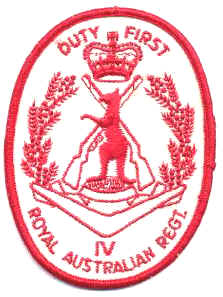 |
During 2/4 RARs deployment to
Rwanda on Operation Tamar in 1994, that the Government made
the decision to unlink the 2nd/4th Battalion.
This was a result of the
1994 Defence White Paper that identified the need for an additional
Infantry Battalion to enhance the Army's capability to meet strategic
guidance requirements.
On 15 Jan 95, LTCOL R.C. Smith who was
posted to Land Headquarters and had carried out the detailed planning to
raise the Battalion, was appointed Commanding Officer of 4 RAR.
A Project Team for the raising of the
additional infantry battalion was formed on 23 Nov 94, to begin
planning. |
|
This consisted initially of the CO, LTCOL R.C. Smith and RSM,
WO1 K.R. Kahler. Shortly afterwards additional personnel with future
appointments in the Battalion were posted to the Project Team.
The Courts Martial Room at Land
Headquarters, Victoria Barracks, Paddington along with numerous
computers and mobile phones, were made available for the Project Team to
commence work. This was the beginning of the new technology Battalion.
Manning was approved for 69 ARA and 103 GRes soldiers in the first year,
building to 3 ARA rifle companies and 1 GRes rifle company by 1998. The
General Reserve would also have proportional elements in Support and
Admin Companies giving respective strengths of 556 ARA and 150 GRes.
Therefore, the total unit strength would be 706.
The 2nd/4th Battalion was unlinked by
the Chief of the General Staff, LTGEN J.C. Grey, AO on a parade at
Samichon Lines, Lavarack Barracks, Townsville at 1500 hrs on 1 Feb 95.
After the parade the colours were
escorted to Holsworthy on 2 Feb 95, by the Adjutant, CAPT S.J. Kluver
and SSGT G.J. Stanworth, where a ceremonial parade was held at 1600 hrs
to uncase the colours to mark this auspicious occasion. The Reviewing
Officer for the parade was MAJGEN P.N. Arnison, AO and the Host Officer
was BRIG A.J. Molan, AM Commander 1st Brigade.
The Battalion enjoyed strong ties with
the 4th Infantry Battalions Association and was barracked at Jordan
Lines, Holsworthy. It was intended the Battalion would occupy Tobruk
Lines when 5/7 RAR (Mech) moved to Darwin in 1998. The Battalion finally
moved into Tobruk Lines in November 2000 prior to Christmas, to enable
The Battalion to conduct training before deploying to East Timor in
April.
4 RAR (COMMANDO)
In 1996, a decision was made to
convert the Battalion to a Special Forces unit and on 1 Feb 97 was
re-rolled to 4 RAR (Cdo). Regular serving members were given the
opportunity to undertake special forces training or elect a posting to a
conventional forces unit. No GRes positions existed in the new structure
and reserve members discharged or posted to GRes units. LTCOL R.C. Smith
and WO1 Kahler remained in the unit during the first year before handing
over to LTCOL N.L. Thompson on 29 Nov 97 and WO1 A. Forsyth on 12 Jan 98
respectively.
The initial years were busy creating a
structure and recruiting members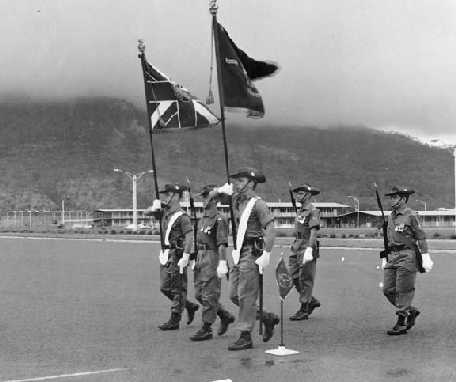 suitable for commando training. Bravo Coy was raised first followed by
Charlie Coy in 1999, both taking 2-3 years to reach maturity. The pace
of battalion life during these development years was hectic with
capability development, equipment acquisition and training, focussing
every memberís attention. LTCOL N.L. Thompson (29 Nov 97-17 Nov 99)
and WO1 A. Forsyth (12 Jan 98-16 Jan 00) oversaw much of this
consolidation period in an era involving preparation for the Sydney
Olympics and much of the ADF being focussed on operational deployments
to East Timor.
suitable for commando training. Bravo Coy was raised first followed by
Charlie Coy in 1999, both taking 2-3 years to reach maturity. The pace
of battalion life during these development years was hectic with
capability development, equipment acquisition and training, focussing
every memberís attention. LTCOL N.L. Thompson (29 Nov 97-17 Nov 99)
and WO1 A. Forsyth (12 Jan 98-16 Jan 00) oversaw much of this
consolidation period in an era involving preparation for the Sydney
Olympics and much of the ADF being focussed on operational deployments
to East Timor.
LTCOL J.J. Sengelman assumed command
of the unit on 18 Nov 99 and quickly prepared Bravo Coy to assume
operational responsibilities on 1 Mar 00, in accordance with OPO
serials. In addition to this, Charlie Coy were tasked with providing
support to SASR during the Olympics. LTCOL Sengelman was assisted by his
new RSM, WO1 R.E. Lambert, who commenced work on 17 Jan 00.
|
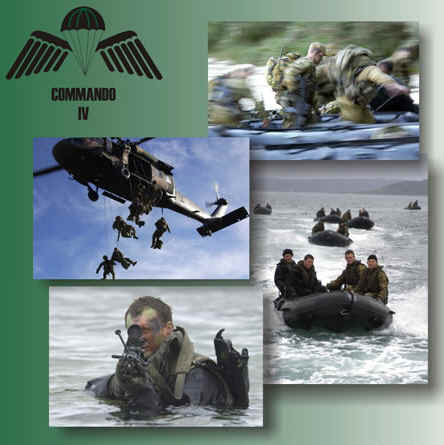 |
Some of 4RAR Commando
served in Iraq in 2003. They were back up, ready reaction for SASR |
|











 The
Battalion's advance party departed Australia on 30 Apr 71, for the unit's
second tour of Vietnam only this time lead by LTCOL Hughes and the RSM WO1
W.T.C. Thompson took over on 1 Jun 70 and looked after the men until 14 Aug
73.
The
Battalion's advance party departed Australia on 30 Apr 71, for the unit's
second tour of Vietnam only this time lead by LTCOL Hughes and the RSM WO1
W.T.C. Thompson took over on 1 Jun 70 and looked after the men until 14 Aug
73. 

 suitable for commando training. Bravo Coy was raised first followed by
Charlie Coy in 1999, both taking 2-3 years to reach maturity. The pace
of battalion life during these development years was hectic with
capability development, equipment acquisition and training, focussing
every memberís attention. LTCOL N.L. Thompson (29 Nov 97-17 Nov 99)
and WO1 A. Forsyth (12 Jan 98-16 Jan 00) oversaw much of this
consolidation period in an era involving preparation for the Sydney
Olympics and much of the ADF being focussed on operational deployments
to East Timor.
suitable for commando training. Bravo Coy was raised first followed by
Charlie Coy in 1999, both taking 2-3 years to reach maturity. The pace
of battalion life during these development years was hectic with
capability development, equipment acquisition and training, focussing
every memberís attention. LTCOL N.L. Thompson (29 Nov 97-17 Nov 99)
and WO1 A. Forsyth (12 Jan 98-16 Jan 00) oversaw much of this
consolidation period in an era involving preparation for the Sydney
Olympics and much of the ADF being focussed on operational deployments
to East Timor.